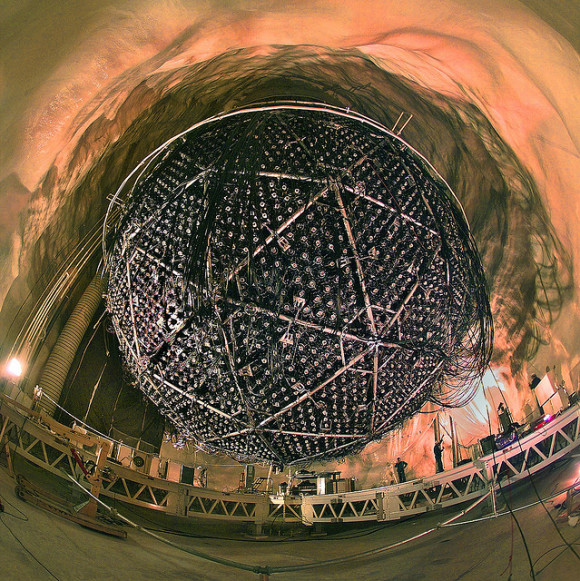The AMON team would like to congratulate Takaaki Kajita from the Super-Kamiokande (SK) Collaboration and Arthur B. McDonald from the Sudbury Neutrino Observatory (SNO) Collaboration for winning the Nobel Prize in Physics for 2015. Takaaki Kajita and Arthur B. McDonald lead the neutrino experiments, which demonstrated that neutrinos change their flavour and thus have mass.

Outside view of the SNO detector before water fill. Credit: Lawrence Berkeley Nat’l Lab – Roy Kaltschmidt, photographer. CC BY-NC-ND 2.0
In 1962, Z. Maki, N. Nakagawa and S. Sakata [1] proposed a model with neutrinos being mixed states of massive eigenstates. The implication of this model was the prediction of a neutrino oscillation phenomenon: a neutrino can be detected in a flavour eigenstate that differs from its originally weakly produced state due to the mixing of its mass eigenstates.
Neutrino oscillations were first observed in atmospheric neutrinos by the Super-Kamiokande experiment in 1998 [2]. This was the first direct evidence of physics that goes beyond the scope of the minimal Standard Model. The Sudbury Neutrino Observatory was the first experiment to measure distinctively the total solar fluxes of electron neutrino and all known active neutrino flavours in 2002 [3]. This milestone unambiguously proved that solar neutrinos change flavour on their way to the Earth.
After the discovery by these two experiments, which “has changed our understanding of the innermost workings of matter and can prove crucial to our view of the universe” as the Nobel committee stated, neutrino field focused on the precise determination of the fundamental properties of this elusive particle: neutrino mixing parameters. The next challenges in neutrino physics include determination of the neutrino nature (Dirac vs Majorana), absolute neutrino mass, CP violating phase and neutrino mass hierarchy. More exciting years are coming along.
Congratulations to all our colleagues who worked on the SK and SNO experiments!
References
[1] Z.Maki, M.Nakagawa and S.Sakata, Remarks on the Unified Model of Elementary Particles, Prog.Theor.Phys.28, 870, 1962.
[2] S. Fukuda et al. (The SK Collaboration) Evidence for Oscillation of Atmospheric Neutrinos, Phys.Rev.Lett. 81, 1562-1567, 1998.
[3] Q. R. Ahmad et al. (The SNO Collaboration) Direct Evidence for Neutrino Flavor Transformation from Neutral-Current Interactions in the Sudbury Neutrino Observatory, Phys. Rev. Lett. 89, 011301, 2002.

Why this site don’t have other languages support?